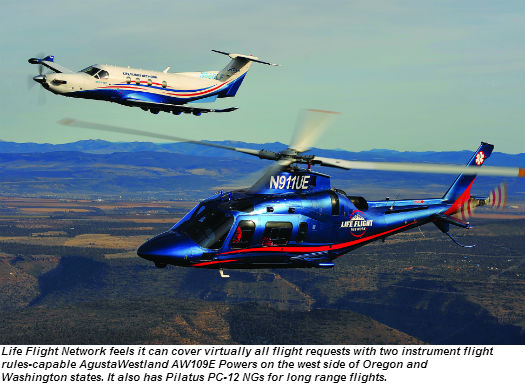
With an area of operation spanning hundreds of thousands of square miles of the Pacific Northwest and Intermountain West, the not-for-profit air medical service Life Flight Network (LFN) certainly has its work cut out. The Portland, Ore.-based operation, which celebrated its 35th anniversary in 2013, has grown from humble beginnings into a multiple award-winning service with 13 rotary-wing and five fixed-wing bases spread throughout the states of Oregon, Washington, Montana, and Idaho.
Owned by a consortium of Legacy Emanuel Medical Center, Oregon Health & Science University (OHSU), Providence Health & Services – Oregon, and Saint Alphonsus Regional Medical Center, LFN’s mission is simple — to save lives by providing high quality critical care transportation in the safest and most efficient manner possible.
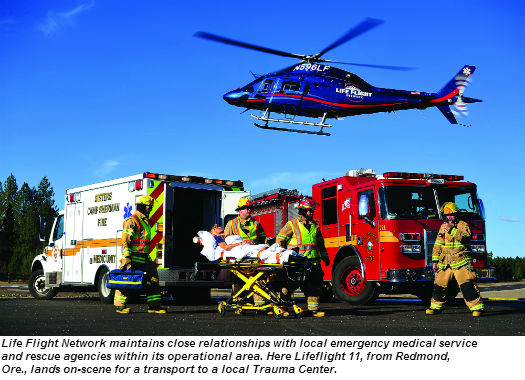
Since the organization’s founding in February 1978, the program has safely transported over 90,000 patients and its flourishing membership program has grown to cover 155,000 people. Established by Emanuel Hospital (now Legacy Emanuel Medical Center) with a single Aérospatiale Allouette-3, Emanuel Life Flight (as the program was then known) was the first hospital-based air ambulance on the West Coast, and one of only four hospital-based air ambulances in the United States at the time. It became Life Flight Network following a merger with Aircare, a Providence Health System flight program, in 1993. OHSU also joined the ownership consortium at this point, bringing LFN under the wing of the three largest healthcare providers in the Portland metropolitan area.
The next few years saw LFN obtain a new a Bell 230 (which was later replaced with a Bell 430) and expand into fixed-wing services. A contract from the Washington Department of Transportation in 2003 required the addition of a Bell 206L LongRanger, which was used to fly patients across the Columbia River from Rainer, Ore., into Longview, Wash., while the Lewis and Clark Bridge closed at night for maintenance; during the day, it operated from a new base in Aurora, Ore. The LongRanger continued in operation until 2007, when it was replaced with the faster and more capable Bell 407.
In a major strategic move, LFN was separated from its hospital structure in 2007, allowing the company to independently navigate the increasingly competitive air medical industry. Michael Griffiths, who had been LFN’s chief flight nurse for the previous five years, was promoted to CEO. His vision and years of air medical experience would help shape LFN’s rapid expansion over the following years. As it began life as a separate entity, LFN had two rotor-wing aircraft, one fixed-wing aircraft, and just over 40 employees and contracted aviation staff.

The company transitioned to a Eurocopter fleet of three AS350 AStars and one EC135 after its board approved new rotary-wing bases late in 2007 — more than doubling the size of LFN. Its network expanded the following year with the addition of rotary-wing bases in Eugene, Ore.; Dallesport, Wash.; and Longview, Wash., opening the door to new and growing communities.
While the breadth of the service was undergoing huge change, the high standard set decades earlier was being maintained and even improved — and this was recognized in 2008, when LFN received the Oregon EMS Commitment to Quality Award. This was followed by the Association of Air Medical Services (AAMS) Program of the Year award in 2009; given to a program with excellent management, leadership, and proven marketing success, the award also recognizes high quality of patient care, a commitment to safety, and high levels of customer and community service.
Indeed, 2009 became something of a banner year for the program, as it also saw LFN add the Life Flight program of Boise, Idaho-based Saint Alphonsus Medical Center, which became the first new owner in LFN’s consortium since its formation in 1993. This made LFN one of the largest not-forprofit air medical programs in the United States. Another merger saw Life Flight of the Portneuf Medical Center in Pocatello, Idaho, become part of LFN in 2011.
Recent years have seen additional bases opened in Lewiston and Sandpoint in Idaho, as well as La Grande, Redmond, and Pendleton in Oregon. A base in Butte, Mont., began service in January 2014.
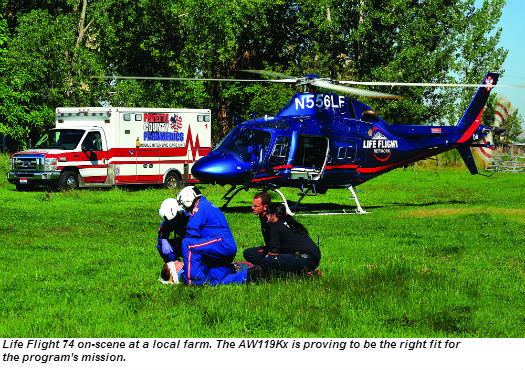
A new fleet for an expanded service
Over the last year, Life Flight Network has been going through a comprehensive helicopter fleet replacement program, with 15 new AgustaWestland AW119Kx “Koalas” and two previously-owned Agusta A109E “Power” (now called AW109E) helicopters coming on-line progressively.
The new aircraft are replacing LFN’s fleet of 11 Eurocopter AS350 B3s, with the increase in cabin space, an essential requirement for the organization, the primary reason for the switch. With a 142-knot cruise speed, two patient capability, and a large enough cabin to work on the entire length of a patient, the Koala was a good fit for LFN. Twelve were in service at the beginning of this year, with another three expected to be delivered before the end of 2014.
The Koala is powered by a single Pratt & Whitney Canada PT6B-37A turbine engine, which produces 1,002 shaft horse-power. LFN’s AW119Kx have a night vision goggle (NVG) compatible cockpit, equipped with the Garmin G1000HTM integrated flight deck. The system has synthetic vision, helicopter terrain avoidance warning system (HTAWS) and satellite weather reporting, giving the pilot a new level of situational awareness. Equipment in the cabin includes a Zoll Propaq MD cardiac monitor, a LTV 1200 ventilator, an Alaris Minimed pump, a Storz C-MAC PM video laryngoscope, and a Thermal Angel fluid warmer.

The two AW109E twin-engine helicopters are being used for instrument flight rules (IFR) operations in the Pacific Northwest and coastal regions to help cope with the low visibility, rain and cloudy conditions that typically occur in these areas during late fall and winter. LFN is currently developing a low-level route structure to allow the AW109Es to fly IFR to hospitals below the icing levels experienced in the Pacific Northwest. “With the low ceilings and icing conditions we experience up here, we are really trying to find a way to maintain consistent operations,” LFN director of operations Ryan Swakon told Vertical 911. The cabin of the A109Es carries the same equipment as the Koalas.
On the fixed-wing side, LFN decided to purchase four Pilatus PC-12NGs, with the first of these going into service in late 2013. The remaining PC-12NGs will come on-line this year. The aircraft has been praised by its crews for its exceptional range, which allows it to travel throughout the western and mid-western states.
The communications center for the entire fleet is in Boise, Idaho. Operating 24 hours a day, 365 days a year, it is staffed by certified flight communicators responsible for coordinating incoming transport requests for service. These include all scene requests and interfacilty transfers. The center maintains communication throughout an aircraft’s flight, with satellite tracking used to monitor each aircraft’s movement from takeoff to landing.
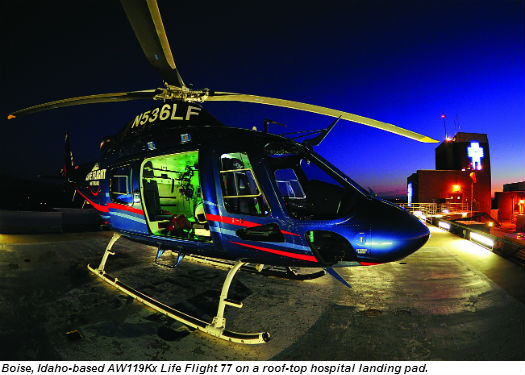
Across a broad network
Operating across four states means LFN’s flight crews encounter wide-ranging geography, weather conditions and temperature variations. Portland’s specialty and trauma hospitals are regular destinations for flights from throughout the network, while on the east side of Oregon, at the Pendleton, La Grande, and Ontario bases, flights to hospitals and trauma centers in Boise are common.
Flight crews in the high desert around southwest Idaho and eastern Oregon can face weeks of heat over 90 F (32 C) in July and August, and then watch the temperature drop to 0 F (-18 C) during December and January. Scene calls in southern Idaho can require flights over many miles of desert and ranch land, or over the rugged Frank Church-River of No Return Wilderness, or a high mountain pass near Sun Valley.
The balance of interfacility transports and scene calls varies from base to base, but is roughly split 50/50. Because of the active lifestyles of the citizens of these regions, there can be a huge range of potential scene calls — from boating and other on-water incidents to desert accidents while off-roading, hunting or climbing. Farm and ranching accidents are also very common. “I’ve flown out of a few different bases and anything that can happen, does happen — especially when we cover such a large area,” Teresa Cozzetti, a flight nurse, told Vertical 911. “Obviously the warmer months are when we see the most outdoor activity call outs, but winter brings its own kinds of accident. During these months, we are in the mountains picking up skiers and snowboarders, and we see the typical motor vehicle accidents.”

The right people
TriState CareFlight operates and is the Federal Aviation Administration Air Carrier Part 135 Certificate holder for LFN’s rotary-wing aircraft, employing the pilots and mechanics who fly and maintain the aircraft. LFN requires a minimum of 2,500 flight hours from new pilots, with most averaging more than 5,000 rotary-wing flight hours. The program currently has 60 rotary-wing line pilots, with an average of four per base plus a few extra “float” pilots, along with 12 fixed-wing pilots, with more coming online later in 2014. There are four additional management pilots who regularly fly operationally.
“Our pilots are expected to have specialized training to successfully navigate the environments where we operate, including certification in aircraft type and training for offairport landing zones and mountain flying,” said Swakon. Because LFN is a strong believer in the safety advantages provided by NVGs for EMS operations, it trains new hire pilots in their use and also maintains an active training program for continued education.
Chuck Hagele, LFN’s director of maintenance, told Vertical 911 that the network was split into three regions for maintenance, with each having a hub, co-located with operational rotary-wing and fixed-wing bases. LFN has chosen AgustaWestland’s progressive maintenance schedule for its fleet: light inspections are carried out at the bases while heavier work, such as an 800-hour inspection, is performed at one of the maintenance hubs. “The hub and spoke model allows for expensive specialized equipment and commonly used parts to be stored at the hubs, where it is a short drive to the spoke bases when either are needed,” said Hagele. All mechanics are required to attend factory training for the aircraft and engine they are assigned.
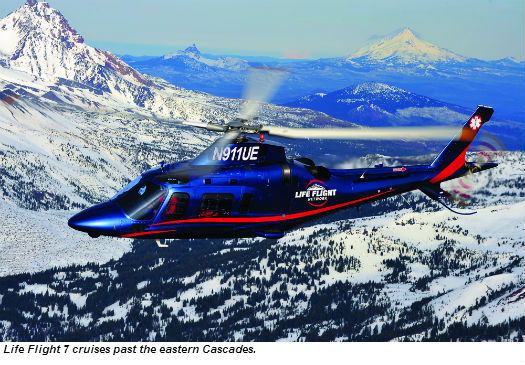
Critical Care
LFN maintains the highest levels of clinical standards and has been accredited by CAMTS (the Commission on Accreditation of Medical Transport Systems) since 2006. Transport crews are equipped to care for both pediatric and adult patients with emergency conditions related to trauma, neurology, obstetrics, cardiac, vascular, pulmonary, sepsis, and other medical problems.
“We are called upon to maintain the highest clinical standards under a variety of situations, so LFN employs critical care flight nurses with a minimum of five years of ICU/ED/ Trauma experience and flight paramedics with a minimum of five years of experience as a paramedic,” Suzie Brennan, LFN’s director of clinical operations, told Vertical 911. “These highly-skilled personnel have the ability and resources to perform a multitude of essential medical functions during a wide range of patient transports.”
All clinical team members participate in bi-annual advanced skills training (including surgical procedures) in a high-fidelity simulation lab. Ongoing comprehensive clinical rotations at tertiary and quaternary care facilities and via human patient simulators ensure LFN’s clinical team maintains the highest standards in critical care transport.
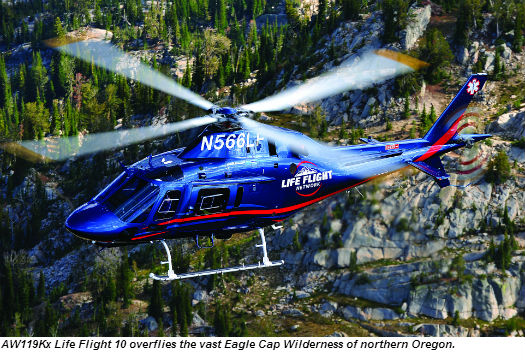
The program is also keen to provide its crews with the very latest technology to help improve patient care. For example, it recently purchased 14 Storz C-MAC PM “pocket monitor” video laryngoscopes — a small, lightweight device with a 2.4- inch video monitor that helps medical crews insert breathing tubes into a patient. At the time of purchase, LFN was one of only two flight programs in the United States to use the innovative new device. “The service we provide has us treating people on one of the worst days of their life,” said LFN CEO Michael Griffiths. “We have consistently provided our critical care teams with the tools they need to save lives and provide better outcomes for our patients. There are a number of less expensive alternatives to the C-MAC PM, but none match the benefits this new tool delivers to our team and their patients.”
These are certainly interesting times for LFN, with the unprecedented growth it has enjoyed over the past few years a testament to the quality of service. But the program has no intention of resting on its laurels — this includes taking the steps needed to obtain its own FAA Part 135 Air Carrier Certificate, which is expected to receive approval by February 2014. “LFN is moving into the future with a proven and dynamic team; fully prepared to face a changing landscape in the years to come,” said Griffiths. “We will always maintain a rigorous focus on safety, quality, and customer service to ensure we consistently provide the industry’s highest level of critical care service to the region.”





